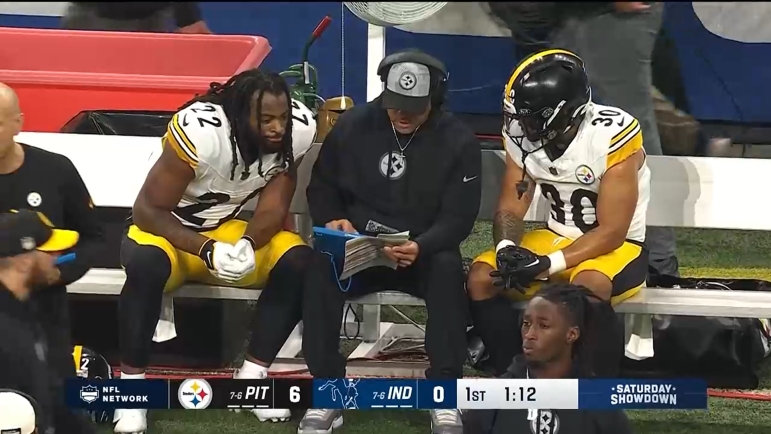The Pittsburgh Steelers’ decision to decline RB Najee Harris’ fifth-year option has generated discussions about the future of the position. With the non-move, Harris is now slated to reach free agency in March—with Jaylen Warren a restricted free agent. The only running back of note they have behind the two is Cordarrelle Patterson.
But the Steelers only use Harris and Warren out of the backfield if they can help it. That’s been the story for the past two years when they’ve had both healthy, and that won’t change this year. But how will they manage the division of labor within that concise platoon? Steve Palazzolo of Pro Football Focus cautions against leaning too far into the favored Warren.
“I think Harris is still good. I think he might still be a 60-40 type of guy,” he told Andrew Fillipponi and Chris Mueller on 93.7 The Fan. “It happens a lot where you have the backup, a guy like Warren, and you say, ‘Well, he was averaging five and a half, whatever he ended up with yards per carry, give him more touches’. I think you want to be careful with that.”
Running backs who serve as complementary runners have the advantage of fresh legs against battered defenses. We’ve seen time and time again second fiddles put up high efficiency numbers for that reason. Rarely do they maintain near the same level of efficiency if given a starring role, as Palazzolo indicated.
Ahmad Bradshaw was perhaps one of the more successful backs in transferring to a more featured role. Yet Tony Pollard’s average dropped to 4.0 from over a yard better when he hit 250-plus carries last season. Similarly, former Ravens RB Gus Edwards dropped from 5.0 or above to 4.1 last year on a career-high 198 attempts.
“We saw that with Tony Pollard in Dallas, where once he became the workhorse, it wasn’t nearly as effective,” Palazzo said. “I think maybe still a 60-40 split with Harris. And then…there’s this element of, if you’re the Steelers, you know you’re not bringing Najee back, necessarily, do you just work him harder a little bit in the last year?”
Last season, the Steelers got 252 carries out of Najee Harris at 4.1 per clip. Jaylen Warren saw 149 rushing attempts while averaging 5.3 yards per carry, but aided by a 74-yard outlier. That single run accounts for roughly an increase of 0.6 yards per carry on his average. Yet he still averaged better than 4.7 yards per attempt on his other 148 rushes. But, again, what do his numbers look like with another 100-plus stacked on top?
“I still think Najee [Harris] is pretty good, he was just very inconsistent,” Palazzolo said of the Steelers’ lead runner. “I still think he’s effective at getting what’s there, whereas Jaylen’s a better big-play threat. And you want to lean into that enough, but not too much when it comes to Warren so you don’t overdo it.”
Warren got roughly 37 percent of the carries last year, though the percentage ticked up as the season wore on. The Steelers occasionally came close to evenly distributing their work, but there is no exact science here. The simplest way to approach this dilemma is to play the running back who is successful at any given time. When he’s not, put the other one in, then wash, rinse and repeat as needed.







